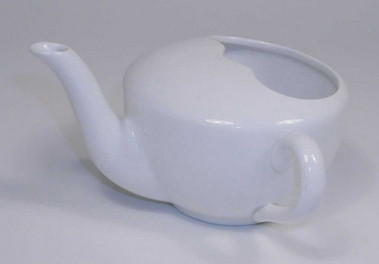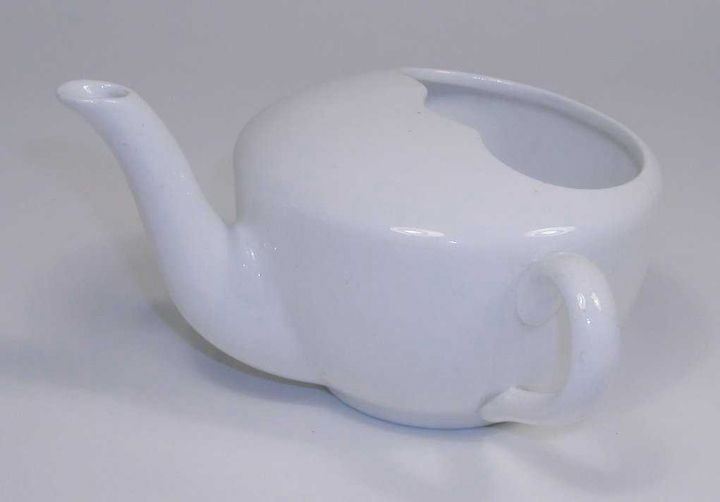Invalid Cup, Victorian-Early 20th Century, Original
When you are ill and lying flat in bed, drinking from a cup can be a messy business. This invalid feeder or (as it was also called) invalid feeding cup was used to feed invalids who were too weak or ill to sit up. In Victorian times, wealthy families used to nurse sick children, parents and grandparents at home. They bought an invalid feeder from the chemist's shop and used it to feed sick members of the family.
Patients drank beef tea, or a mixture of diluted milk and flour called pap. Invalid foods tended to be runny and not very tasty. The invalid feeder was ideal for giving liquid meals to bedridden patients. The food was cooked and then spooned into the feeder. The patient was propped up slightly and drank from the feeder, holding the handle. If they were very weak, a nurse or helper sat next to them and fed them.
Invalid feeders were common in Victorian times and people carried on using them into the 20th century. This invalid feeding cup dates from the first half of the 20th century. It is factory made in white ceramic. 'Made in England' is stamped in blue-green on its base.
This feeder looks like a milk jug with a round bowl, curved spout and handle. The handle at the side let the invalid hold it to drink. The half-cover over the top stopped the liquid from overflowing. A long spout poured the liquid straight into the patient's mouth so that none was wasted or spilt on the bedclothes.
Patients drank beef tea, or a mixture of diluted milk and flour called pap. Invalid foods tended to be runny and not very tasty. The invalid feeder was ideal for giving liquid meals to bedridden patients. The food was cooked and then spooned into the feeder. The patient was propped up slightly and drank from the feeder, holding the handle. If they were very weak, a nurse or helper sat next to them and fed them.
Invalid feeders were common in Victorian times and people carried on using them into the 20th century. This invalid feeding cup dates from the first half of the 20th century. It is factory made in white ceramic. 'Made in England' is stamped in blue-green on its base.
This feeder looks like a milk jug with a round bowl, curved spout and handle. The handle at the side let the invalid hold it to drink. The half-cover over the top stopped the liquid from overflowing. A long spout poured the liquid straight into the patient's mouth so that none was wasted or spilt on the bedclothes.

Height:8.2cm
Invalid feeding cups were well used in the Victorian era. This was a time when illness struck large numbers of people. Chronic diseases like scarlet fever, tuberculosis and pneumonia were common. Sufferers spent a long time being ill and bedridden. In most homes there was almost always a family member ill or recovering from an illness.
A large number of invalids were treated at home. Although there were many hospitals in the Victorian era, these were generally for the poor and homeless. Wealthy families had the luxury of being able to afford doctor visits, and a female relative or nurse looked after long-term invalids. These families had many items for the care and comfort of the invalid. The invalid feeder was kept in the sick room with other equipment like bedpans, food warmers and sputum (spitting) mugs.
Doctors recommended the invalid feeder in cases where the patient could, or should, not sit up in bed. Books on care and diet at the time advised patients to eat little. It was thought that hearty foods would make the disease stronger, as well as the patient. Doctors said that patients should eat runny foods that could be digested easily and the invalid feeder was ideal for serving runny food.
Patients were given beef tea, caundle or pap in the feeders. Beef tea was the most common food for bedridden invalids. It was a thin broth made from boiling pieces of beef in water, and at only 6 calories it was certainly a sparing meal! Caundle was a warm gruel made with flour and oatmeal or rice. Pap was a cooked mixture of water, milk and bread or flour. These were far from delicious. Sometimes an egg, carrot or sugar was added to flavour caundle or pap and to tempt the invalid's taste buds. Wine was a popular addition too.
There were lots of different styles in Victorian invalid feeders. On some, the spout had sieve holes to control the flow of the liquid. On others, the handle was at the back, which let a nurse or carer hold it easily to feed the invalid. The cups were often decorated with blue landscape or flower prints. Glass feeding cups were also used, but these were quite fragile and broke easily, so few have survived today.
This invalid feeding cup dates from the 20th century. The curved spout and rounded half cover show that it was made after 1900. Earlier feeding cups have straight spouts and flat covers, while 18th century feeders often do not have a handle.
Invalid feeders are similar to baby feeders. Mothers sometimes used invalid feeders to feed their babies by hand. Some feeders had spouts with a cuff or ring near the end to hold a rubber nipple securely.
Invalid feeders were often used with food warmers. After it was cooked, the patient's food was kept warm in a small pot above a candle. The warmer sat next to the invalid's bed so that they could eat a little whenever they felt like it.
A large number of invalids were treated at home. Although there were many hospitals in the Victorian era, these were generally for the poor and homeless. Wealthy families had the luxury of being able to afford doctor visits, and a female relative or nurse looked after long-term invalids. These families had many items for the care and comfort of the invalid. The invalid feeder was kept in the sick room with other equipment like bedpans, food warmers and sputum (spitting) mugs.
Doctors recommended the invalid feeder in cases where the patient could, or should, not sit up in bed. Books on care and diet at the time advised patients to eat little. It was thought that hearty foods would make the disease stronger, as well as the patient. Doctors said that patients should eat runny foods that could be digested easily and the invalid feeder was ideal for serving runny food.
Patients were given beef tea, caundle or pap in the feeders. Beef tea was the most common food for bedridden invalids. It was a thin broth made from boiling pieces of beef in water, and at only 6 calories it was certainly a sparing meal! Caundle was a warm gruel made with flour and oatmeal or rice. Pap was a cooked mixture of water, milk and bread or flour. These were far from delicious. Sometimes an egg, carrot or sugar was added to flavour caundle or pap and to tempt the invalid's taste buds. Wine was a popular addition too.
There were lots of different styles in Victorian invalid feeders. On some, the spout had sieve holes to control the flow of the liquid. On others, the handle was at the back, which let a nurse or carer hold it easily to feed the invalid. The cups were often decorated with blue landscape or flower prints. Glass feeding cups were also used, but these were quite fragile and broke easily, so few have survived today.
This invalid feeding cup dates from the 20th century. The curved spout and rounded half cover show that it was made after 1900. Earlier feeding cups have straight spouts and flat covers, while 18th century feeders often do not have a handle.
Invalid feeders are similar to baby feeders. Mothers sometimes used invalid feeders to feed their babies by hand. Some feeders had spouts with a cuff or ring near the end to hold a rubber nipple securely.
Invalid feeders were often used with food warmers. After it was cooked, the patient's food was kept warm in a small pot above a candle. The warmer sat next to the invalid's bed so that they could eat a little whenever they felt like it.

Height:8.2cm

When you are ill and lying flat in bed, drinking from a cup can be a messy business. This invalid feeder or (as it was also called) invalid feeding cup was used to feed invalids who were too weak or ill to sit up. In Victorian times, wealthy families used to nurse sick children, parents and grandparents at home. They bought an invalid feeder from the chemist's shop and used it to feed sick members of the family.
Patients drank beef tea, or a mixture of diluted milk and flour called pap. Invalid foods tended to be runny and not very tasty. The invalid feeder was ideal for giving liquid meals to bedridden patients. The food was cooked and then spooned into the feeder. The patient was propped up slightly and drank from the feeder, holding the handle. If they were very weak, a nurse or helper sat next to them and fed them.
Invalid feeders were common in Victorian times and people carried on using them into the 20th century. This invalid feeding cup dates from the first half of the 20th century. It is factory made in white ceramic. 'Made in England' is stamped in blue-green on its base.
This feeder looks like a milk jug with a round bowl, curved spout and handle. The handle at the side let the invalid hold it to drink. The half-cover over the top stopped the liquid from overflowing. A long spout poured the liquid straight into the patient's mouth so that none was wasted or spilt on the bedclothes.
Patients drank beef tea, or a mixture of diluted milk and flour called pap. Invalid foods tended to be runny and not very tasty. The invalid feeder was ideal for giving liquid meals to bedridden patients. The food was cooked and then spooned into the feeder. The patient was propped up slightly and drank from the feeder, holding the handle. If they were very weak, a nurse or helper sat next to them and fed them.
Invalid feeders were common in Victorian times and people carried on using them into the 20th century. This invalid feeding cup dates from the first half of the 20th century. It is factory made in white ceramic. 'Made in England' is stamped in blue-green on its base.
This feeder looks like a milk jug with a round bowl, curved spout and handle. The handle at the side let the invalid hold it to drink. The half-cover over the top stopped the liquid from overflowing. A long spout poured the liquid straight into the patient's mouth so that none was wasted or spilt on the bedclothes.




















